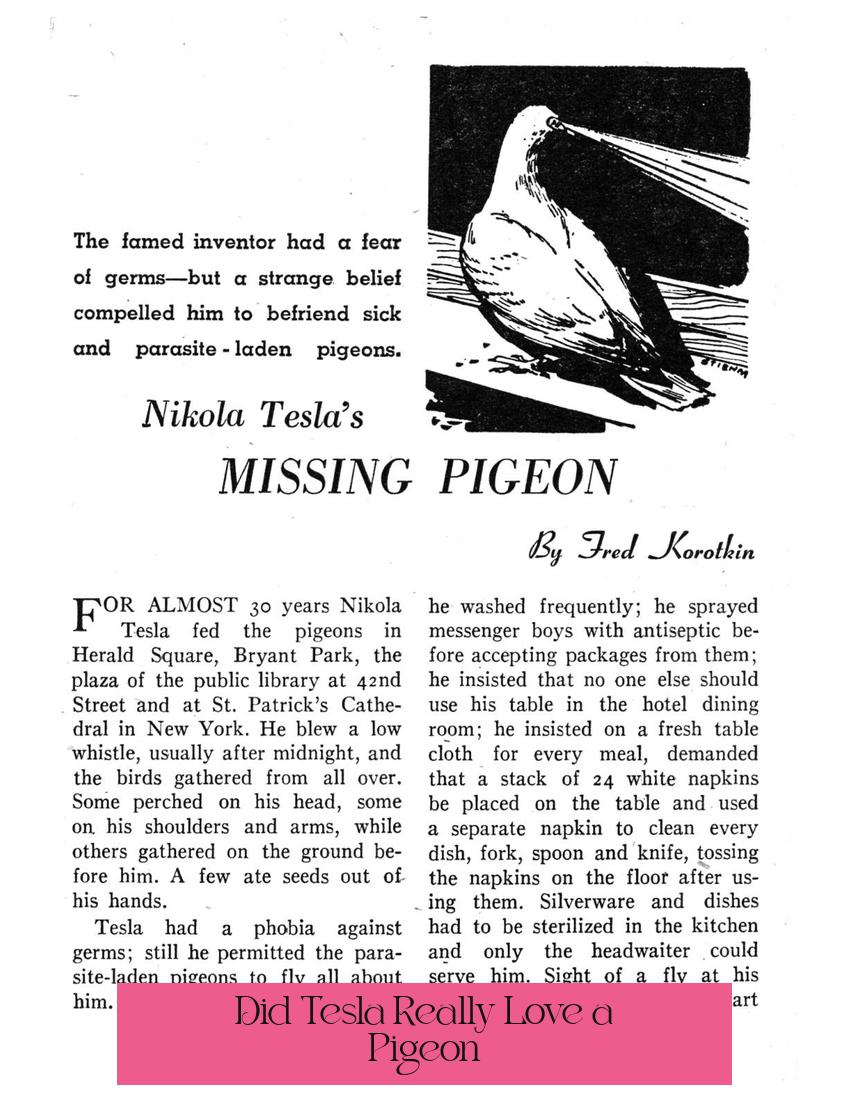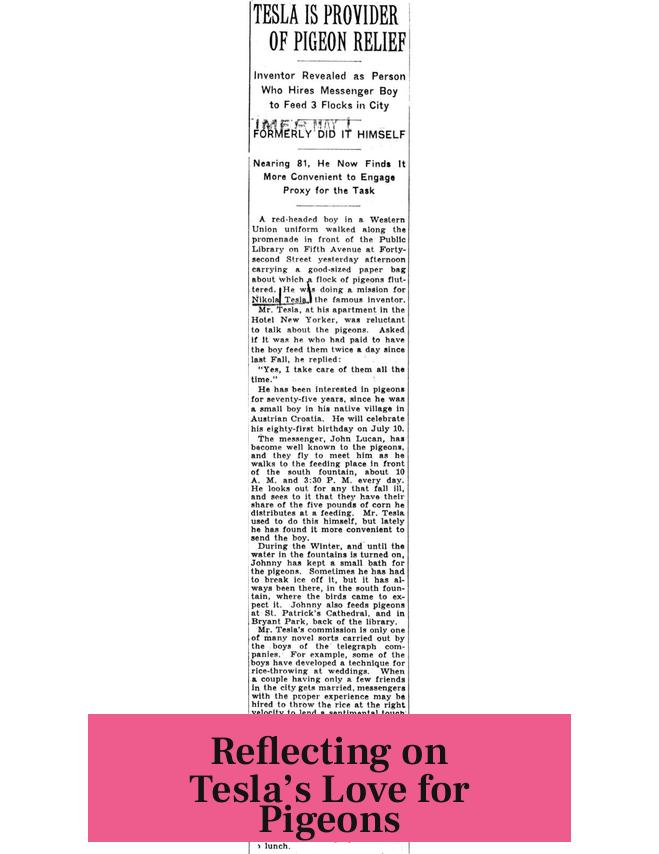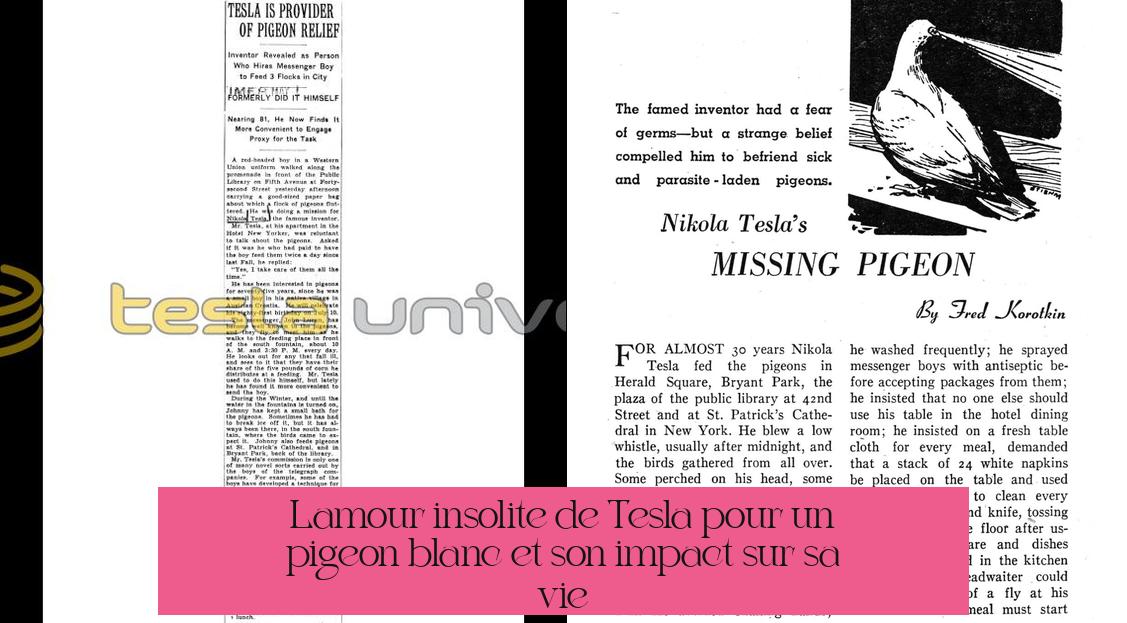Did Tesla Really Love a Pigeon?

Nikola Tesla had a genuine and profound affection for pigeons, especially one white pigeon he considered a soulmate. This affection was more than casual bird feeding; Tesla formed a deep emotional connection with these birds during his years in New York.
Tesla’s Fondness for Pigeons
Tesla spent many hours weekly feeding pigeons in parks. He took injured pigeons into his hotel suite to care for them, often keeping his windows open to invite birds inside. This habit sometimes created a mess, but he accepted it.
- He asked hotel chefs to prepare special seed mixes for the pigeons.
- Despite being a known germophobe, Tesla ignored risks linked to lice and diseases carried by birds.
- Tesla’s passion puzzled acquaintances, given his obsessive cleanliness.
- Feeding and nursing pigeons became a key emotional outlet for the inventor in old age.
The bond was so strong that pigeons became Tesla’s companions during his later years. His care for these birds was consistent and intense.
The Special White Pigeon
Tesla never married, believing marriage would interfere with his scientific work. He once said few great inventions were made by married men. Instead, he embraced a unique love for a white pigeon.
“I loved that pigeon as a man loves a woman, and she loved me. As long as I had her, there was a purpose to my life.”
This particular pigeon visited him regularly. Tesla saw her not just as an animal but as a companion who gave meaning to his life. His lifestyle was deeply shaped by this unusual affection.
Incident in 1922
In 1922, a dramatic event marked Tesla’s relationship with his favorite pigeon. The bird flew into his hotel room showing signs of illness. Tesla claimed he saw a powerful white light radiating from her eyes—brighter than any lamp he produced.
- The pigeon appeared to communicate her impending death.
- Despite Tesla’s nursing efforts, the bird died in his hands.
- Tesla reported feeling that his life’s work ended with her death.
This incident deeply affected Tesla emotionally. He described the light from her eyes as a “dazzling, blinding light,” reinforcing the profound spiritual connection he believed he shared with the pigeon.
Tesla’s Personality and Context of His Pigeon Love
Tesla exhibited many eccentricities and obsessive behaviors. He insisted on rituals involving the number three, detested pearls, and avoided intimacy, fearing it would interfere with his inventions.
- His obsession with numerology and cleanliness hints at possible obsessive-compulsive disorder.
- His germophobia contrasted sharply with his tolerance for pigeons carrying diseases.
- His celibate life and unique bond with pigeons reveal his unconventional emotional world.
His hotel room on the 33rd floor of the Hotel New Yorker became the stage for his unusual pigeon companionship.
Later Life and Emotional Impact of the Pigeon’s Death
Following the loss of the white pigeon, Tesla’s health and mental state declined. He lived 21 more years but became more erratic and struggled financially.
- He sold patent rights to survive.
- Reportedly offered sensational “death ray” inventions to pay bills.
- His death in 1943 came not long after the loss of his beloved bird.
- Friends speculated his heart failure was linked to grief over the pigeon’s death.
The emotional connection Tesla had with the white pigeon remained central to his final years. The bird represented more than companionship; she symbolized purpose.
Key Takeaways
- Tesla had a deep, documented affection for pigeons, especially one white female pigeon.
- His love defied his germophobic nature and obsessive habits.
- The white pigeon’s death in 1922 profoundly influenced Tesla’s emotional and mental state.
- Tesla’s bond with this pigeon reflected his unique personality and life circumstances.
- Pigeons provided Tesla with emotional support during his isolated later years.
Did Tesla Really Love a Pigeon? Exploring the Curious Romance of a Scientific Genius

If you’ve ever stumbled across an odd historical tidbit and thought, “Wait, did Nikola Tesla really love a pigeon?”—you’re not alone. This question mixes the brilliant mind of one of history’s greatest inventors with a feathered companion, creating a story as quirky as Tesla himself. Yes, Tesla really did love a pigeon, and his affection went far beyond a casual fondness. But what drove this eccentric passion? Let’s take a deep dive into the man, the myths, and the message behind Tesla’s remarkable bond with his avian friends.
Nikola Tesla: Eccentric Genius with an Unusual Soft Spot
Tesla often conjures images of gleaming coils and crackling electricity. His groundbreaking work in electric power, especially the invention of the Tesla coil and the promotion of alternating current (AC), revolutionized how humanity uses energy. This Serbian-American engineer was a brilliant mind with over a hundred patents to his name. However, few know about his softer, more peculiar side—his obsession with pigeons.
While many appreciate Tesla’s scientific achievements, his contemporaries sometimes found him difficult to understand. His strict routines, phobias, and strange habits left people puzzled. Yet, for Tesla, pigeons were a source of comfort and emotional connection in a life often marked by isolation.
A Pigeon Whisperer in New York
When Tesla lived in New York City—chiefly in his suite at the Hotel New Yorker—he didn’t merely feed pigeons in the park like many city dwellers. He elevated this practice into what can only be described as an avian love story. Tesla spent hours each week feeding them, often inviting injured or sick pigeons into his hotel suite to nurse them back to health.
His room became an unofficial aviary with windows deliberately left open to welcome feathered visitors anytime. This hospitality resulted, unsurprisingly, in a rather messy environment. Yet, Tesla’s dedication was unwavering. He even went so far as to task hotel chefs with preparing special seed mixes for his pigeons. It’s a tiny glimpse of the tenderness beneath the inventor’s idiosyncratic exterior.
Now, consider this: Tesla was a notorious germophobe. The seeming contradiction of nursing dirty pigeons may strike one as bizarre. But it highlights a complex man navigating his need for connection amid obsessive fears. What drove Tesla to overlook potential health risks for the sake of his feathered friends? The answer seems buried in emotional necessity.
The White Pigeon: Tesla’s Heart and Soul
Among all his pigeons, one stood apart—a white pigeon with whom Tesla shared a profound bond. This wasn’t just pet-owner affection. Tesla openly confessed to falling in love with this special bird, famously stating, “I loved that pigeon as a man loves a woman, and she loved me.”
In many ways, this relationship filled the emotional void Tesla’s celibate, science-driven life left empty. He chose never to marry, explaining that intimacy interfered with his scientific focus. Tesla once claimed that “I do not think you can name many great inventions that have been made by married men.” The white pigeon seemed to embody the purpose and connection Tesla needed.
This isn’t your average bird story—Tesla’s attachment speaks volumes about his solitude and the unique ways humans seek companionship. The pigeon was more than a pet; she was a muse, a partner, and a reason to keep going.
1922: A Night That Changed Tesla Forever
One especially poignant moment occurred in 1922. Tesla’s white pigeon flew unexpectedly into his hotel room. In that instant, Tesla sensed something was terribly wrong. He believed the bird came to tell him she was dying.
“Yes, it was a real light, a powerful, dazzling, blinding light, a light more intense than I had ever produced by the most powerful lamps in my laboratory,” Tesla described, referring to the beam of white light shining from the pigeon’s eyes before it passed.
Whether interpreted literally or symbolically, the radiant light became a mysterious emblem of the bird’s passing. Tesla cradled the pigeon in his hands as she died, overwhelmed by heartbreak. He later confided to friends that at that moment, he felt his life’s purpose was over.
In a poetic way, the incandescent light from his beloved pigeon’s eyes seemed to eclipse even Tesla’s own electrical inventions. It was the end of an era—both emotionally and creatively.
Quirky, Compulsive, and Completely Tesla
Tesla’s affection for pigeons fits neatly among his many eccentric traits. He held peculiar obsessions with the number three, a behavior possibly linked to obsessive-compulsive tendencies. Washing his hands thrice, circling buildings three times before entering, and other rituals were regular behaviors.
He hated pearls to an extreme, outright refusing to converse with women wearing them. He disliked round objects and had an intense phobia of germs. It seems his love for pigeons was a rare exception where emotional needs triumphed over these fears.
Living alone, dedicating countless hours to scientific discovery, Tesla translated his yearning for human connection into this unusual bond. The pigeons offered companionship without the complications of human relationships—a solution perfectly in tune with his singular, focused personality.
After the Pigeon: Tesla’s Twilight Years
Tesla lived for 21 more years following the 1922 event. However, his later life was marked by increasing eccentricity, financial hardship, and fading fame. He sold invention rights to survive, at one point attempting to pay hotel bills based on the promise of a “death ray” weapon—a claim as outlandish as it sounds.
Despite the scrutiny and skepticism, some observers believed Tesla’s emotional bond with the white pigeon affected his mental state deeply. The loss seemed to sap his will, echoing in his waning productivity and solitude. Maybe that glowing white light was a message Tesla alone understood—an emotional call to rest after a life of brilliant work.
Reflecting on Tesla’s Love for Pigeons

What can we learn from Tesla’s peculiarity? Humans are full of contradictions. Here was a man capable of shaking the world with his inventions, yet tenderly devoted to delicate city birds. He wove obsession, loneliness, and genius into a story that challenges our expectations of love and companionship.
His case asks: can affection transcend our conventional notions? Can an eccentric genius find solace in an unconventional bond? Tesla’s answer seems to be a definitive yes.
Some might chuckle at the image of a legendary inventor sneaking injured pigeons into a hotel room. Yet, it’s a striking reminder that behind every great mind lies a complex heart. Tesla’s story echoes the simple truth that even the brightest lights sometimes need the warmth of a friend—feathered or not.
Final Thoughts: Beyond the Myth
Tesla’s love for a pigeon is not just folklore; it’s a documented reality filled with personal anecdotes and heartfelt testimony. It paints a vivid portrait of an inventor whose creativity and isolation intertwined in unexpected ways.
If nothing else, Tesla’s pigeon story invites us to view historical figures not simply as icons or geniuses, but as humans with quirks, affections, and vulnerabilities. Next time you see a pigeon pecking in the park, remember Tesla feeding his feathered friends high up on the 33rd floor of the Hotel New Yorker, lost in thought and love with one very special bird.
- Summary: Tesla’s love for pigeons was profound, outpacing typical pet companionship. His relationship with a special white pigeon reflects his unique personality and solitary life. The bird’s death marked a turning point in Tesla’s life, an emotional moment that shows even geniuses have tender hearts.
Est-il vrai que Nikola Tesla aimait vraiment une colombe ?
Oui. Tesla avait une relation spéciale avec une colombe blanche qu’il a aimée profondément. Il disait que cet amour donnait un sens à sa vie.
Comment Tesla s’occupait-il des pigeons à New York ?
Il nourrissait régulièrement les pigeons au parc. Il ramenait aussi chez lui les pigeons blessés pour les soigner dans sa chambre d’hôtel.
Pourquoi la passion de Tesla pour les pigeons surprenait-elle son entourage ?
Parce qu’il était germophobe. Malgré cela, il accueillait des pigeons dans sa chambre, malgré la saleté causée.
Que s’est-il passé avec la colombe blanche en 1922 ?
La colombe est venue le prévenir qu’elle allait mourir, avec une lumière blanche dans ses yeux. Quand elle est morte, Tesla a senti que sa propre mission était achevée.
Quel impact cette colombe a-t-elle eu sur la vie de Tesla ?
Il considérait cet amour comme vital. La mort de la colombe l’a profondément affecté, marquant la fin symbolique de son travail de vie.
La relation de Tesla avec les pigeons reflète-t-elle une obsession ou un trouble ?
Oui, son comportement obsessionnel autour du chiffre trois et son amour intense pour les pigeons suggèrent qu’il pourrait avoir eu un trouble obsessionnel compulsif.

